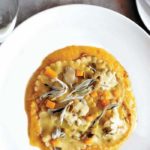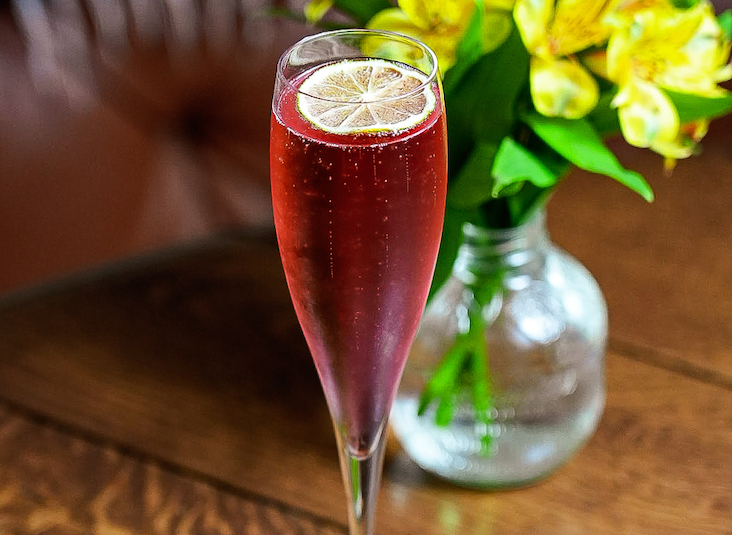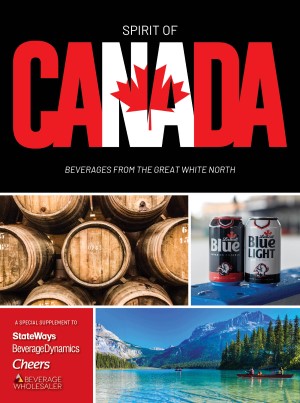Canadian wines are surprisingly diverse.
To our north is a large wine-producing country that until recently wasn’t recognized by most American consumers for much beyond maple syrup and hockey. But that’s changing, as production increases and exports are more widely available.
Canadian wine remains well below the radar. And retailers who do stock Canadian items are more likely to offer iconic icewine than dry wine. Americans are often surprised to learn that Canada makes wine at all — many unable to reconcile their mental images of “wine country” and the “Great White North.”

Inniskillin’s Brae Burn estate vineyard and winery blanketed with snow in Niagara on the Lake, Ontario.
But the trade should pay attention to the success story quietly playing out in our own backyard, in wine regions nestled like jewels along our northern border, primarily Ontario’s Niagara Peninsula and British Columbia’s Okanagan Valley.
While the volume of premium Canadian wine being sold in the U.S. remains tiny, there are plenty of reasons to sit up and take notice. Remarkable improvements in the quality of Canada’s wines, a steady stream of American visitors to Canadian wineries and a recent change in the exchange rate have already sparked a surge in exports to the U.S.
Recently, the Wall Street Journal’s Lettie Teague said that “one of the world’s most exciting new wine regions is in Ontario, Canada.” Last year, Whole Foods featured British Columbia wines in their Pacific Northwest stores, and the Decanter World Wine Awards dubbed an Okanagan Valley wine the “Best Pinot Noir under £15” in 2013. Simply put, there has never been a better time to add Canadian wines to your product mix.
Cool-Climate Adventures
“American wine drinkers are still looking for new experiences in the premium category, for delicious wines from off the beaten track,” says Wine.com’s chief storyteller Wilfred Wong, based in San Francisco. “That open-mindedness applies to unfamiliar ‘New World’ wine regions too, not just quirky grapes or obscure European appellations.”

Bike-riding along the Naramata Bench on the east shore of Okanagan Lake near Penticton, BC, a region known for its dramatic sand cliffs.
In the Americas and southern hemisphere, emerging premium regions are almost always cooler in climate than the established zones. Think Oregon vs. California, or Otago vs. Marlborough. As climate change makes itself felt in North America, it makes perfect sense that southern Canada would be ripe for wine discovery.
Interest in cool-climate wines in general shows no signs of slowing, even in less progressive markets. Steve Pollack serves as the Pennsylvania Liquor Control Board’s “cool-hunter” in his role as lead buyer for the agency’s wildly successful “Chairman’s Selection” program. “Younger wine drinkers are broadening the range of saleable styles by embracing lighter, brighter wines that deliver more refreshment than power,” he says.
These underlying trends may have opened the door for Canadian wines. But tourism surely plays a role in increased demand as well. Every year, three million tourists visit Canadian wineries. Among international visitors, 75% are from the United States — and little wonder. Americans prefer driving over flying when it comes to travel, and most Canadian wine is made in spectacularly beautiful regions adjacent to the borders of New York and Michigan in the east, and Washington in the west.
At Home or on the Road?
“The Canadian wine industry is still in its adolescent stage,” says Donald Ziraldo of Ontario’s Ziraldo Estate Wines, which specializes in superior icewines. As the co-founder of Inniskillin, the charismatic Ziraldo is to Canada as Robert Mondavi is to California: the inspirational leader and intellectual force behind the Canadian estate wine movement. “Converting skeptical gatekeepers abroad takes a lot of persistence in knocking on doors. Top independent vintners know that international recognition and export growth are the keys to long term success, but there’s no question that it’s simpler and cheaper to coast on Canadian demand.”
As a result, exports have not been a priority for most of the biggest players. “There is still a ton of opportunity domestically where the majority of our focus lies for dry wines,” says Ben Dollard, president of Constellation Brands Canada. Constellation’s 2006 purchase of Vincor International made it the largest producer of Canadian wine, owners of some of the country’s most prestigious brands like Inniskillin, Nk’Mip and Jackson-Triggs, as well as value brands sold only in Canada.
But it’s clear from Canada’s national statistics that the tide is turning. Canadian wine exports to the U.S. have quadrupled since 2010, including a 57% single year increase in sales in 2014 alone. This latest spike coincided with a dramatic jump in the value of the U.S. dollar that is making Canadian wines more affordable to Americans.
It can be harder to spot the Canadian wine trend on this side of the border because these wines tend to be lumped into “miscellaneous other” categories. In state-run Pennsylvania stores, sales of wines from Canada have fluctuated quite a bit over the last five years, based largely on how much has been purchased as one-time “luxury” buys. But the top sellers in both volume and dollars have been icewines, and after a few years of decline, the most recent fiscal year shows a 63% increase.
With an increased focus on marketing Canadian wine country to American visitors, and commitments from industry groups to make inroads into the U.S. market, Canada seems determined to move the needle and earn its stripes as a legitimate wine region. Forward thinking estate wineries are stepping up their efforts and setting their sights on the world’s largest wine market next door, just as the global currency markets make premium Canadian wines more affordable.
The time is right, but much work remains to be done. As Ziraldo puts it with the wry delivery of a late night talk show host, “Knowledge of Canadian wine among Americans is fairly consistent with their knowledge of Canada as a whole.”
Author and sommelier Marnie Old is one of the country’s leading wine experts. Formerly the director of wine studies for Manhattan’s esteemed French Culinary Institute, she is best known for her visually engaging books published by DK — the award-winning Wine: A Tasting Course and He Said Beer, She Said Wine.









